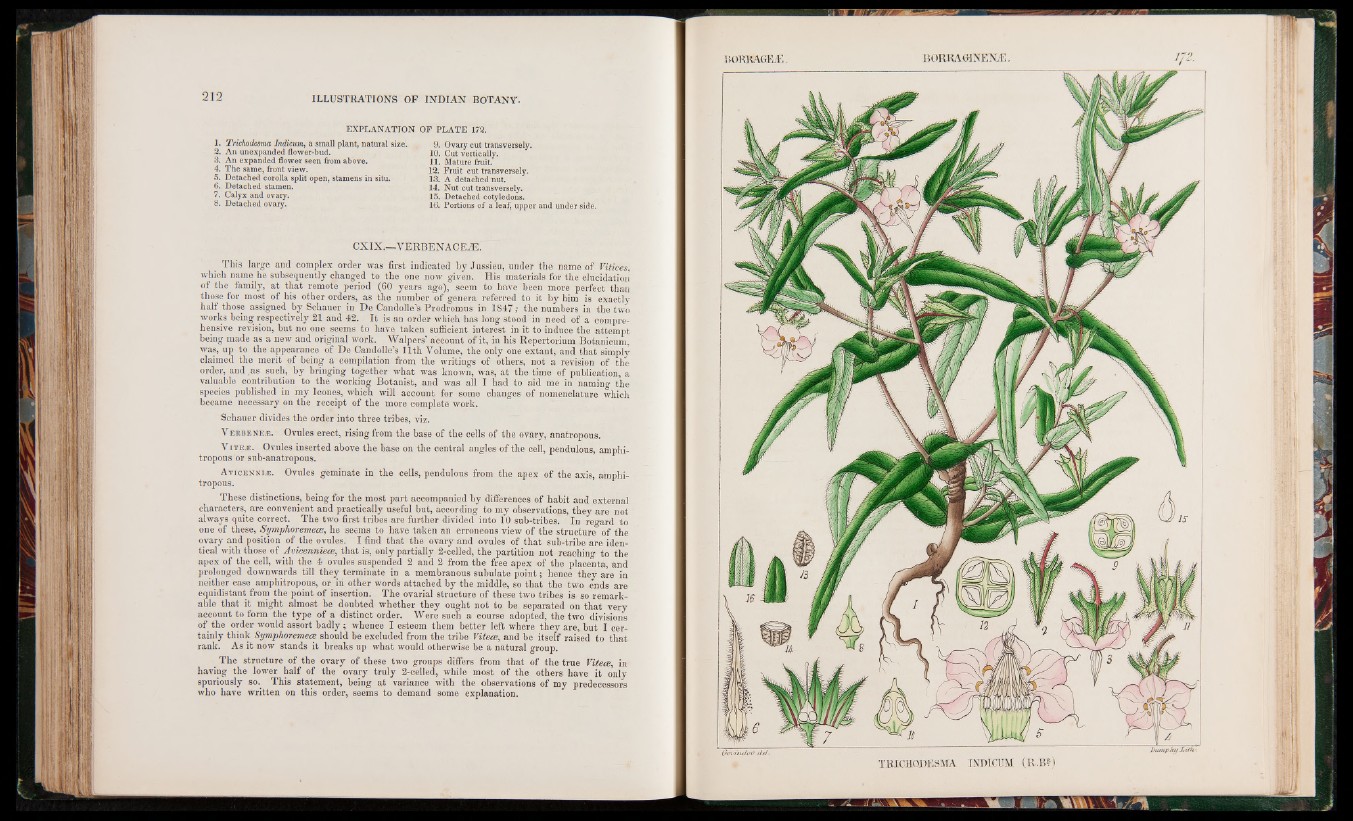
EXPLANATION OF PLATE 172.
1. Trichodesma Indicum, a small plant, natural size.
2. An unexpanded flower-bud.
3. An expanded flower seen from above.
4. The same, front view.
5. Detached corolla split open, stamens in situ.
6. Detached stamen.
7. Calyx and ovary.
8. Detached ovary.
9. Ovary cut transversely.
10. Cut vertically.
11. Mature fruit.
12. Fruit cut transversely.
13. A detached nut.
14. Nut cut transversely.
15. Detached cotyledons.
16. Portions of a leaf, upper and under side.
CXIX.—VERBENACEiE.
This large and complex order was first indicated by Jussieu, under the name of Vitices,
which name he subsequently changed to the one now given. His materials for the elucidation'
of the family, at that remote period (60 years ago), seem to have been more perfect than
those for most of his other orders, as the number of genera referred to it by him is exactly
half those assigned by Schauer in De Candolle’s Prodromus in 1847; the numbers in the two
works being respectively 21 and 42. It is an order which has long stood in need of a comprehensive
revision, but no one seems to have taken sufficient interest in it to induce the attempt
being made as a new and original work. Walpers’ account of it, in his Repertorium Botanicum,
was, up to the appearance of De Candolle’s 11th Volume, the only one extant, and that simply
claimed the merit of being a compilation from the writings of others, not a revision of the
order, and .as such, by bringing together what was known, was, at the time of publication, a
valuable contribution to the working Botanist, and was all I had to aid me in naming the
species published in my leones, which will account for some changes of nomenclature which
became necessary on the receipt of the more complete work.
Schauer divides the order into three tribes, viz.
Verbene.-e. Ovules erect, rising from the base of the cells of the ovary, anatropous.
ViTEiE. Ovules inserted above the base on the central angles of the cell, pendulous, amphi-
tropous or sub-anatropous.
A v ic e n n a . Ovules geminate in the cells, pendulous from the apex of the axis, ainphi-
tropous.
These distinctions, being for the most part accompanied by differences of habit and external
characters, are convenient and practically useful but, according to my observations, they are not
always quite correct. The two first tribes are further divided into 10 sub-tribes. In regard to
one of these, Symphoremece, he seems to have taken an erroneous view of the structure of the
ovary and position of the ovules. I find that the ovary and ovules of that sub-tribe are identical
with those of Avicenniece, that is, only partially 2-celled, the partition not reaching to the
apex of the cell, with the 4 ovules suspended 2 and 2 from the free apex of the placenta, and
prolonged downwards till they terminate in a membranous subulate point; hence they are in
neither case amphitropous, or in other words attached by the middle, so that the two ends are
equidistant from the point of insertion. The ovarial structure of these two tribes is so remarkable
that it might almost be doubted whether they ought not to be separated on that very
account to form the type of a distinct order. Were such a course adopted, the two divisions
of the order would assort badly ; whence I esteem them better left where they are, but I certainly
think Symphoremece should be excluded from the tribe Vitece, and be itself raised to that
rank. As it now stands it breaks up what would otherwise be a natural group.
The structure of the ovary of these two groups differs from that of the true Vitece, in
having the lower half of the ovary truly 2-celled, while most of the others have it only
spuriously so. This statement, being at variance with the observations of my predecessors
who have written on this order, seems to demand some explanation.
TRICHODESMA INDICUM (U.B?)